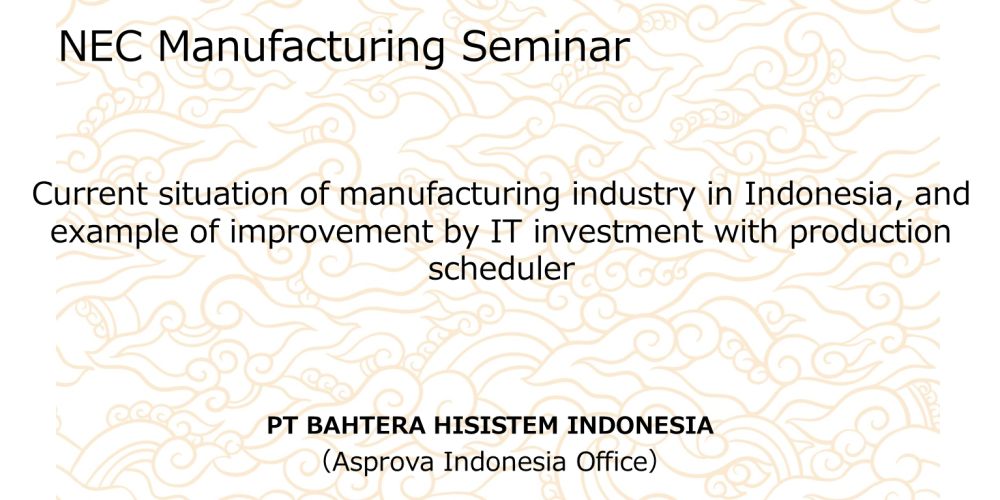In the production management tasks of mass-production assembly factories, which are common in Indonesia's two-wheeler and four-wheeler industries, production planning and capacity planning are two sides of the same coin. Since production planning is formulated based on quantities, there is a strong demand to view capacity planning on a per-machine quantity basis as well. Generally, production and capacity plans are required on a daily or shift basis.
In the minds of Indonesian planners, the thought process is: "How many units will this machine produce today (or this shift)? If it exceeds capacity by a certain number, on which day will that excess be produced? If capacity is insufficient, how many overtime hours are needed?" Consequently, there is a need for a PSI (Production, Sales, Inventory) table in the system to compare production quantities (Production), consumption quantities (Sales or Demand), and inventory quantities (Inventory).
The purpose of planning lies in tracking progress against actual results. For instance, when creating a one-week plan, all quantities displayed at the time of planning are forecast-based figures derived from current inventory levels. As production results are entered, the inventory levels shift, and when the next week's plan is created, the quantities are reset to forecast-based figures based on the current inventory at that time.
When systemizing planning tasks in Indonesia, rather than aiming for minute-by-minute detailed schedule management, it is simpler and more readily accepted by on-site planners to align with production results entered on a daily (or shift) basis and reference them in the same unit.
This blog features articles about production schedulers to help manufacturers in Indonesia who feel the need to systemize production planning (scheduling) tasks but are unsure where to start, providing insights into what a manufacturing system suited to Indonesia might look like.
Evolution from MRP (Material Requirements Planning/Manufacturing Resource Planning) to APS (Advanced Planning & Scheduling)
While creating an MPS by subtracting product inventory from customer orders or forecasts and considering minimum stock levels, the MPS is originally a final product production plan agreed upon by both the sales department, which prioritizes shipping schedules or forecasts from a customer service perspective, and the production planning department (Production Planning and Inventory Control = PPIC), which considers on-site conditions.
In Indonesia, the MPS is often mechanically created by the production planning department based on forecasts and shipping schedules received from the sales department, with little intervention from the sales team during the MPS creation stage. It feels commonplace to see a scenario where, when a delivery delay seems likely at the shipping stage, the sales team hurriedly steps in to follow up with the production site.
The purpose of MRP based on MPS is typically to create a gross production plan for the net requirements during production. The production plan, created by shifting lead times in MRP, only becomes feasible through human efforts such as on-site adjustment capabilities and production preparation (capacity planning and sales planning).
When this reaches its limit, an imbalance between production planning and capacity planning emerges, and inefficient production orders are issued from MRP. As a result, despite sufficient production capacity, unnecessary overtime or weekend work occurs, or intermediate inventory accumulates.
To address this issue, the introduction of Advanced Planning and Scheduling (APS), which considers finite capacity planning without setting time buckets, is considered. Evolution from MRP (Material Requirements Planning/Manufacturing Resource Planning) to APS (Advanced Planning and Scheduling) The core of a production management system is MRP II (Manufacturing Resource Planning), and the core of MRP II is MRP I (Material Requirement Planning), where preparing an accurate MPS (Master Production Schedule) is critical. 続きを見る

APS is the process of seamlessly generating MPS from orders, creating manufacturing orders with MRP, and generating purchase orders after load leveling.
Scheduling Logic of Production Scheduler Asprova
Within the rescheduling logic of the production scheduler Asprova, the list generation phase includes the order collection command, which generates an order list from the order table, and the task collection command, which generates a task list from the task table.
In the command execution phase’s order explosion (Explode orders), the auto-replenishment function generates supplementary orders to cover shortages in task input instructions for orders while referencing the manufacturing BOM to populate the order list.
Task input and output instructions are then generated for both registered and supplementary orders stored in the order list.
During order assignment/peg orders (Assign/peg orders), task usage instructions are generated while considering dispatching rules and resource evaluation properties, and tasks are assigned from the task list. After a temporary assignment to all candidate resources, a final assignment is made to the resource with the highest evaluation based on resource assessment.
The reason order pegging is performed twice—once during order explosion and again during order assignment/peg orders—is that there are cases where re-pegging in FIFO order is necessary based on assignment results, such as minimum inventory levels. Scheduling Logic of the Production Scheduler Asprova The production scheduler Asprova, after the order list or operation list generation phase, generates operation input instructions and operation output instructions in the command execution phase by executing the order explosion command while referencing the BOM. Subsequently, the order assignment/pegging command generates operation usage instructions to perform resource allocation. 続きを見る

Difference Between Infinite Capacity Loading and Finite Capacity Leveling with a Production Scheduler
In Indonesian manufacturing sites, production plans are created with a quantity-based mindset: how many units can be stacked against the shift or daily capacity of machines or lines. If production plans have been created for years using Excel cells representing one shift or one day, this mindset becomes natural.
On the other hand, a production scheduler operates with a time-based mindset, assigning tasks to available time slots like 8:00–17:00. The difference lies in whether objects are generated per shift or day or per production order.
MRP in a production management system calculates requirements by referencing the BOM and generates objects daily on a quantity basis. However, equipment load is calculated with infinite loading from separate masters like the line master (equipment capacity) and item-line master (standard load), designed with the premise of manual load leveling.
By setting standard loads (cycle times) per item for each line and calculating how many minutes of load a line incurs based on order quantities, stacking them on a lead-time-shifted day and comparing them with daily line capacity reveals daily wins or losses.
In contrast, a production scheduler performs leveling based on the premise of not exceeding 100% load to determine whether overflowing line capacity identified from daily stacking results can meet deadlines if assigned earlier. It is designed with the philosophy that production planning and capacity planning are inseparable. Difference Between Infinite Capacity Loading and Finite Capacity Leveling in a Production Scheduler Typically, MRP is referred to as infinite capacity loading, which checks whether orders fall within production capacity. In contrast, the finite capacity leveling of a production scheduler verifies whether a feasible schedule can be created without delays in delivery. 続きを見る

Why Operating an MRP (Material Requirements Planning) System is Difficult in Indonesia
Material Requirements Planning (MRP) calculates net requirements by exploding requirements based on the Master Production Schedule (MPS) and subtracting inventory, while simultaneously determining the timing of purchase or production orders by backward scheduling with lead times. However, due to the influence of "manufacturing lot size" and "lead time shifting," it becomes difficult to see which requirement (MPS) the generated production orders are tied to.
Typically, manufacturing lot sizes and lead times vary by item, and linking production orders resulting from MRP requirement explosion to customer orders becomes complex. The production planning department starts issuing instructions per process outside the plan, but unplanned instructions are labor-intensive. Since the site feels burdened by being tied to instructions despite having target production numbers, the production planning department and the site align in a way that results in unplanned production results (without instructions) becoming the norm.
Additionally, since the essence of MRP lies in accurately calculating net requirements, it avoids generating excess orders by linking delayed orders (time constraint violations) forward, ignoring time constraint violations. This function, which prevents issuing excess orders as confirmed receipts, makes it harder for system operators to see the linkage between orders.
Since forecast information and confirmed orders overlap in duration, the system must avoid double registration. The method of replacing forecasts with confirmed orders is to "add only new confirmed orders and replace forecasts," which theoretically prevents both double registration of confirmed orders and forecasts simultaneously.
Generally, data management for issued production instructions (remaining production) in planning functions is less clear compared to order backlogs, purchase backlogs, or issued invoices in performance functions. Therefore, every time forecast information is replaced by confirmed orders, rules such as issuing production instructions only from confirmed orders are needed to avoid affecting already issued instructions.
When producing seven days’ worth of shipments in bulk, it means "issuing production instructions for seven days’ worth of shipments of a product, which is a customer order item, as one manufacturing lot." The target items for consolidation are products, the output items of the final process. Similarly, when issuing a purchase order for ten days’ worth of material requirements as one purchase lot, the target output item for consolidation is the material. Reasons Why Operating an MRP (Material Requirement Planning) System Is Difficult in Indonesia The reasons why operating an MRP (Material Requirement Planning) system in Indonesia is challenging include the difficulty in tracking which demand a generated production order is linked to due to the influence of varying "production lot sizes" and "lead time offsets" per item, as well as the complexity of considering links with already-issued production orders when deducting forecasts with confirmed orders. 続きを見る

Reducing Opportunity Loss and Excess Inventory Risks with a Production Scheduler in Indonesia
Problems faced by factories include delivery delays and excess inventory (dependent variables) that cannot be directly controlled. A significant cause could be the productivity of bottleneck processes (independent variable), which can be directly controlled.
If the production efficiency of bottleneck processes can be maintained at 100%, the factory’s production capacity can be fully utilized.
Inventory inherently serves two purposes: safety stock for the days when the order lead time exceeds the manufacturing lead time, and a buffer to prevent stopping bottleneck processes.
However, in reality, overproduction occurs due to fear of order backlog (opportunity loss) risks, leading to excess inventory, or delayed ordering due to fear of inventory costs results in insufficient inventory.
The benefits of introducing a production scheduler include improved cash flow through reduced lead times and inventory, as well as end-to-end visibility from order receipt to production and procurement.
However, this assumes accurate master data such as parts configuration, cycle times, item processes, lot sizes, and standard packaging quantities, along with current inventory levels.
The maximum effect is achieved when a single person creates the production schedule for all processes end-to-end. Introducing a production scheduler to streamline production flow, yet having multiple planners create plans in a bucket-relay style as before, defeats the purpose. Reducing the Risks of Opportunity Loss and Excess Inventory with a Production Scheduler in Indonesia In Indonesia, an increasing number of Japanese manufacturing companies are implementing production schedulers to create production plans that can adapt to market demand fluctuations. In this presentation, we will explain the implementation process and benefits of production schedulers from the perspectives of why inventory is necessary, why inventory is a cost, and the trade-off between opportunity loss and excess inventory. 続きを見る

Multifaceted Profit Management and Delivery Delay Prevention Demanded by Japanese Manufacturers in Indonesia
A frequent issue in Indonesian manufacturing is the inability to manage order backlogs due to a disconnect between the sales and shipping departments, resulting in production departments ignoring the production schedules created by the production planning department and producing at their discretion.
The root cause of this issue is the lack of proper product inventory management.
Ideally, the sales department should collaborate with the production planning department to create the Master Production Schedule (based on product completion dates), issue shipping instructions to the shipping department, and manage how much has been shipped and how much remains against customer orders—known as order backlog management.
However, when product inventory shortages become chronic at the shipping stage, the shipping department, rather than the sales department, becomes the point of contact with customers. This breaks the linkage between customer orders and shipping schedules, leading the production department to produce at its own discretion to meet shipments, rendering the production planning department’s schedule meaningless. Accurate Cost Management and More Multifaceted Profit Management Sought in Indonesia Amid Indonesia’s COVID-19 pandemic, trends in systemization (DX) consultations from Japanese manufacturing companies highlight two key points: the need for accurate cost management and more multifaceted profit management, and an awareness of production management that prevents delivery delays. 続きを見る

Production Management Systems Supporting Manufacturing to Win Global Competition in Indonesia
A challenge faced by manufacturing in Indonesia is that, with economic growth raising national income levels and the development of information tools like SNS, consumer preferences have diversified. However, amidst a flood of goods and information, products quickly lose appeal, shortening product lifespans.
As a result, demand forecasting in the supply chain becomes difficult, order quantities shrink into smaller lots, and frequent order changes occur. This burden multiplies as it ripples through the supply chain, making optimal inventory control challenging. To avoid opportunity losses, a conservative approach is often taken, inevitably increasing inventory costs.
Too little inventory in the supply chain heightens the risk of order backlogs and missed shipping opportunities, while too much inventory incurs interest costs—a trade-off problem. To resolve this, a production planning system that considers the company’s production equipment supply capacity is necessary.
By considering supply capacity, processes connect smoothly, shortening manufacturing lead times and reducing in-process inventory. This automatically lowers inventory interest costs, extending the period cash can be held, contributing to the company’s profitability. Production Management System Supporting Manufacturing to Win Global Competition in Indonesia Having worked in manufacturing systems in Indonesia for a long time, I’ve noticed that compared to the past, customers frequently change order quantities and delivery dates. This makes it hard to revise production plans in time, affecting raw material procurement and often leading to discussions about having too much or too little inventory. 続きを見る

Steps to Systemize Production Management Tasks to Turn On-Site Efforts into Competitive Strength in Indonesia
The era of "just stably delivering limited product types to major customers" has shifted to a trend of multi-variety, small-lot production, increasing the burden on manufacturing.
To handle multi-variety, small-lot production with limited equipment, the idea is to subdivide production lines and increase shared lines to boost overall utilization rates. However, with smaller lots, lead times per process shorten, inevitably increasing setup changes like mold replacements or cleaning.
Variations in the total manufacturing lead time from initial process input to completion make delivery date responses difficult. On-site, it’s hard to prioritize since the linkage with orders is unclear, worsening delivery compliance rates. To avoid line stoppages due to material shortages, excess material and work-in-progress inventory accumulates.
One challenge for Indonesian factories is rising labor costs. One way to increase output at such times is efficiency improvement (reducing man-hours). Within the internal supply chain from procurement to production and shipping, shortening time enhances the added value of time and internal resources.
However, blindly shortening time isn’t the solution. If only the efficiency of a prior process improves without matching efficiency in subsequent processes, work-in-progress inventory increases. Optimizing one department doesn’t necessarily optimize the whole, and added value doesn’t increase. Steps to Systemize Production Management Operations to Transform On-Site Efforts into Corporate Competitiveness in Indonesia In Indonesia, as manufacturing diversifies its production methods in proportion to the growing fluctuations in domestic market supply and demand, it becomes critical to appropriately revise plans in response to order changes and implement process management that visualizes progress against production instructions issued to the shop floor. 続きを見る

Key Points for Selling and Implementing Production Schedulers in Indonesia
It’s often said that automating production planning tasks in Indonesian manufacturing is difficult, but the production scheduler Asprova is utilized and effective across various industries like automotive parts, consumer goods, and chemical liquids.
However, since production schedulers are still relatively unknown in Indonesia, convincing clients that "automating production planning tasks" offers sufficient cost-effectiveness is challenging. Explaining it from the angle of "automating worker capacity planning" tends to resonate more with Indonesian production planners.
While a production management system analyzes the present based on past performance data, a production scheduler repeatedly reschedules using numerous parameter settings to output desired results. Even if a client asks, “Can it do this?” and it’s theoretically possible with a production scheduler, if it can’t be demonstrated on the spot, it’s as good as “impossible.”
The factors influencing production planning are vast and complex, so production schedulers are equipped with many properties like planning parameters, masters, and orders. Even if these are “correctly” set, an optimally scheduled result isn’t guaranteed—it merely imparts a certain tendency to the schedule outcome.
Expressing production plan optimization in broad terms might be “a production plan that avoids capacity overload, prevents delivery delays, and levels utilization rates.” However, in a country like Indonesia, prone to demand fluctuations, exchange rate changes, and logistics disruptions, the definition of optimization shifts with market conditions. Simulations with a production scheduler aim to approach what’s optimal for the current manufacturing site.
Even in private companies, personalistic business practices remain strong, and in manufacturing, there seems to be a greater focus on managing people than on delivery dates or costs.
The collapse of the Suharto regime in 1998, followed by multi-party democratic elections and constitutional amendments establishing civilian control and separation of powers, means Indonesia’s parliamentary democracy has a short history, which may influence this.
Additionally, foreigners are prohibited from engaging in HR roles, reflecting the principle under the Pancasila (Five Principles) that, to prioritize ethnic diversity, only Indonesians can evaluate Indonesians. Key Points for Sales and Implementation of Production Schedulers in Indonesia While the recognition of production schedulers in Indonesia is still low, they address core production management tasks—such as daily load calculations for sub-resources like molds and personnel, and creating production schedules for main resources like machines with those as constraints—that even expensive ERP packages cannot handle. 続きを見る

Challenges in Operating Production Management Systems in Indonesia: Issuing Production Orders and Entering Results
Production orders are crucial for breaking down production plans based on order information to the manufacturing site. Entering results against production orders is the greatest operational challenge in a production management system and a key criterion for the success or failure of its implementation.
To issue production orders and enter results while clearly maintaining the linkage between order information and production plans, the MRP function of the production management system must be utilized. Issuing production orders via Excel tends to cause discrepancies with the site and makes links with order information unclear. The need for manufacturing instructions to link planning and performance Production instructions hold significant importance in breaking down a production plan based on order information for the shop floor. Entering performance data against these instructions is the greatest operational challenge in managing a production management system and a key criterion for determining the success or failure of its implementation. 続きを見る

Extending Asprova’s Functions via COM Interface
Asprova’s main body provides Hooks to execute plugins at event occurrence timings. The plugin key, an access point representing these events, corresponds to WordPress’s do_action or apply_filters hooks.
The relationship between middleware and components up to DB access via ADO resembles the process of shipping cargo from a shipper to a consignee via sea transport.
To access an RDB, Excel, or text file (Consignee) from a development application program (Shipper), you request an intermediary, the OLE DB data provider (Forwarder), to handle it. However, dealing directly with OLE DB involves cumbersome paperwork, so ADO (cargo operator) takes care of it. Extending Asprova Functionality Through the COM Interface The production scheduler Asprova exposes a COM interface, allowing functionality to be extended through EXE files or plugins (DLLs). It retrieves project objects deployed in memory from EXE or DLL files, accessing lower-level table objects in Asprova. 続きを見る

The Asprova main body provides Hooks to execute plugins at specific event timings. These access points, represented by plugin keys, correspond to WordPress’s do_action hook or apply_filters hook.
Impact of Production Scheduler Results on Task and Order Status
In the production scheduler Asprova, all tasks have a date-time fix level and a quantity fix level. Manually moving a task sets its date-time fix level to 10, causing preceding and following tasks to be pulled in during rescheduling. Entering actual quantities sets the date-time fix level to 40, overwriting the planned quantities of subsequent process tasks with actual quantities during rescheduling. The Impact of Production Scheduler Performance Data on Operation In the production scheduler Asprova, completing a generated operation sets the order containing that operation to "In Progress." Reverting the operation to "Planned" returns the order to "Not Started." Completing the order marks all related operations as complete, but reverting the order to "Not Started" does not erase operation performance data or return them to "Planned." 続きを見る

Reflecting Constraints Like Molds and Workers in Equipment Production Schedules
Equipment investment can’t be done overnight, but workers can be flexibly managed at low cost through reassignments or new hires. Raising the utilization rate of main resources via worker capacity planning holds significant meaning for factory management.
Setting mold change time as the setup time for the main resource makes it an internal setup (stopping the line or machine). Setting 120 minutes for the main resource’s pre-setup task and 0 for the sub-resource’s pre-setup task stops the machine for 120 minutes of internal setup.
Setting mold change time as the sub-resource’s setup time makes it an external setup (performed without stopping the line or machine). Leaving the main resource’s pre-setup task blank and setting 120 minutes for the sub-resource’s pre-setup task keeps the machine running during the 120-minute external setup. Methods to Reflect Constraints Such as Molds and Workers in Equipment Production Schedules The number of molds available, setup time for mold changes, mapping between molds and resources, and maintenance schedules significantly impact production plans based on primary resources. Sub-resources, such as workers or molds, which act as constraints on primary resources, can be reflected in the production plan. 続きを見る

Differences Between Assembly and Process-Based Production Plans Created by a Production Scheduler
In process-based manufacturing, a continuous line is used, so tasks in the current process and the next process occur consecutively without gaps, and tasks from other orders never interrupt.
Additionally, process-based manufacturing often uses tanks. While waiting for the preparation task in the tank to complete and flow to the next process, no tasks occur in the current process, but there’s a constraint against assigning other orders to the tank until the contents have fully flowed out. Differences Between Production Planning for Assembly-Type and Process-Type The reason why package systems are developed with assembly-type manufacturing processes in mind is that standardizing operations is easier. In process-type manufacturing, a continuous line is used, meaning that tasks in the current process and the next process are performed consecutively without any idle time, and there is no chance for tasks from other orders to interrupt. 続きを見る

Production Plans Considering Raw Material Inventory Constraints with a Production Scheduler
To create a plan that prioritizes production from orders with available raw material inventory, the production scheduler Asprova, during backward scheduling, first assigns “supplementary raw material orders generated from customer orders that are linked to purchase orders or order backlogs other than on-hand inventory.
” This naturally assigns orders linked to on-hand inventory last, creating a plan that prioritizes production from orders with material inventory. Production Plan Created with a Production Scheduler Considering Raw Material Inventory Constraints If assignments are made forward from the initial process using raw materials, a plan that naturally consumes inventory first can be created. However, if assignments are made backward from processes closer to shipping, manufacturing orders for work-in-progress are generated first, and inventory is allocated to the final shortfall, potentially preventing a plan that prioritizes inventory consumption. 続きを見る

Standard Cost Calculation with Production Scheduler Asprova
In Asprova’s item table, raw material unit prices, labor rates, and allocation rates are set per cost element breakdown of the item.
However, Asprova lacks a function to automatically calculate labor or allocation rates from fixed cost budgets, so these are calculated externally in Excel and set in the item table. Standard Cost Calculation with a Production Scheduler Feasible in Indonesia If unit prices, wage rates, and allocation rates can be set by cost item in the production scheduler Asprova, planned production quantities and planned labor hours can be calculated. This enables budgeting for the next period based on sales forecasts, broken down by product, product group, machine, and customer. 続きを見る

Latest Production Scheduling Methods Using AI in Indonesia
The Solver option command in the production scheduler Asprova implements a genetic algorithm from machine learning to search for optimal production scheduling solutions. This enables rapid identification of optimal values satisfying conflicting trade-off conditions, previously considered difficult.
The fact that the difficulty of introducing production schedulers in Indonesia—once a high hurdle—has decreased to the point where even consulting or sales companies without IT expertise can handle it signifies that the latest AI-driven paradigm shift is commoditizing production schedulers. The Latest Methods for Production Scheduling Using AI in Indonesia In the scheduling of production lines in manufacturing, genetic algorithms, a type of machine learning, have made it possible to search for optimal solutions to improve production efficiency. In Indonesia as well, the commoditization of AI is causing a paradigm shift in the field of manufacturing systems. 続きを見る


